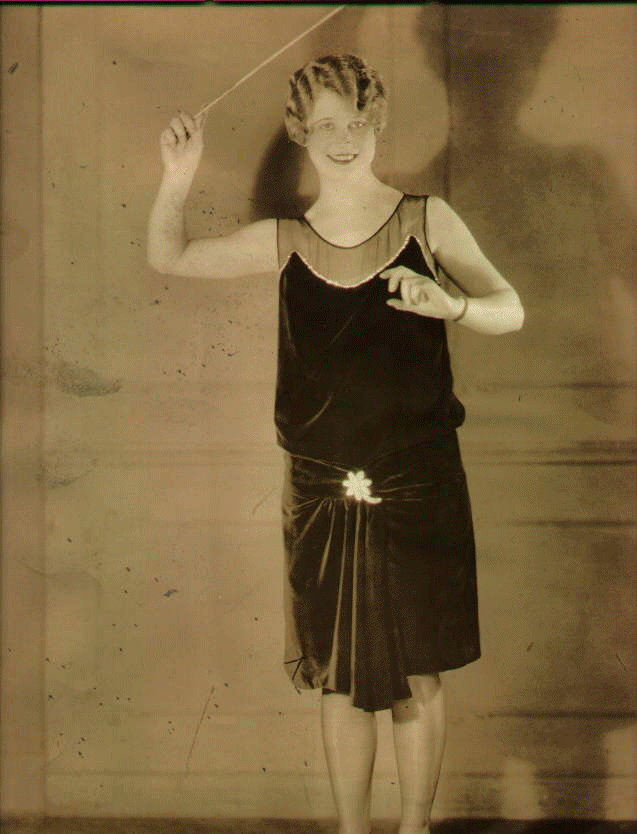
Copyright held by Thelma Terry's daughter, Patti, and used here by her permission. |
Bassist and Bandleader Thelma Combes
by David Apolloni Updated 21 April 2000 |

Copyright held by Thelma Terry's daughter, Patti, and used here by her permission. |
Bassist and Bandleader Thelma Combes
by David Apolloni Updated 21 April 2000 |
| Thanks to Thelma's family (who responded in January, 2000 to a webpage
inquiring about her here at the Combs-Coombs website) , we now know more.
Thelma Combes (not "Coombs", as Condon had reported) was born on Sept.
30, 1901 in Michigan. Thelma’s mother’s name was “Stevenson” and
so Thelma, as it turns out, is related to Adlai Stevenson. Thelma’s
parents divorced early in Thelma’s life, and Thelma’s mother moved to Chicago with her three girls to acquire work as a seamstress for the wealthy Runner family in the suburb of Austin. The Runners were involved in the Chatauquas. (This was an organization originating in the U.S. Methodist Church in the 19th century which dedicated itself to cultural education, especially dramatical and musical education. Members moved from community to community in tents.) It is here that Thelma deliberately chose and learned to play string bass, and evidently became very accomplished so quickly that she took first chair at age 18 in the Chicago Women's Symphony Orchestra. As one would expect, she went to Austin High School (hence her association with many white jazz musicians of the so-called "Austin High Gang", such as Freeman and Jacobson). It is unclear exactly how Thelma became interested in |
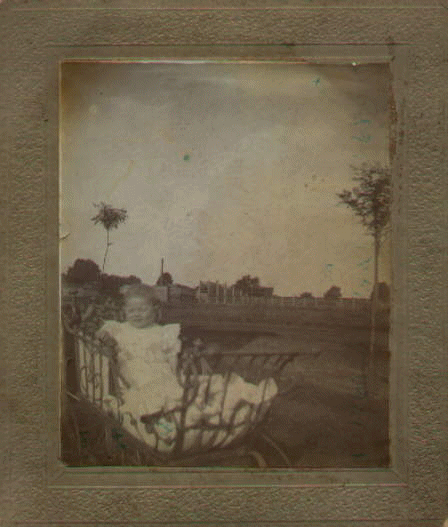 and used here by her permission. |
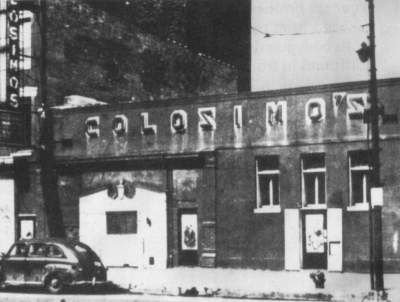 |
jazz, but very soon, she was involved in playing in nightclubs in Chicago. She rose very quickly to the top of the entertainment business in Chicago. We see her in two early photographs (perhaps around 1923) playing in Colosimo’s Orchestra. (“Big Jim” Colosimo was the chief mobster in Chicago until 1920--Colosimo’s was apparently both a place where the elite like Enrico Caruso and Sophie Tucker went and also a place where notorious underworld activities went on. Colosimo himself and shot and killed there, and Al “Scarface” Capone, Colosimo’s successor, received his nickname because of wounds from a battle there.) A jazz musician in those days had to work with gangsters as part of their occupation, and Thelma was no exception. Although it implies nothing wrong or illegal on her part, part of what consistantly immerges about |
Late that summer [of 1926] I went to work at the Vanity Fair, a cafe at Broadway and Grace Street, complete with floor show, dance teams, singers, funny men, lines of girls, and plenty of customers. The band leader was Art Cope, a violinist. Jack Gardner, who had just written a hit song , "Bye Bye Pretty Baby", played piano. Teddy Arnold was the drummer. When I went to work the first night I saw a bass fiddle resting in the corner. While I was tuning my banjo a beautiful girl walked in. She kept coming toward me, stepped up on the bandstand, and went to the fiddle. "Nice to see you," she said to me casually. "I'm the bass player." Her name was Thelma Coombs,and she had been held over from the previous band. When I heard her behind me in the first number I knew she was a musician. This, I thought, is wonderful - a beautiful blond in the rhythm section, a first class cafe, and good pay. Wonderful was the right word. The job lasted ten months. I made well over a hundred dollars each week, and all that winter Thelma was my date. She was a guy's girl; I never had to worry about her no matter where we were, and we were in some curious places. Often we cabareted on the south side until seven or eight o'clock in the morning. It never bothered Thelma; if she got tired or bored she got up quietly and went home by herself.
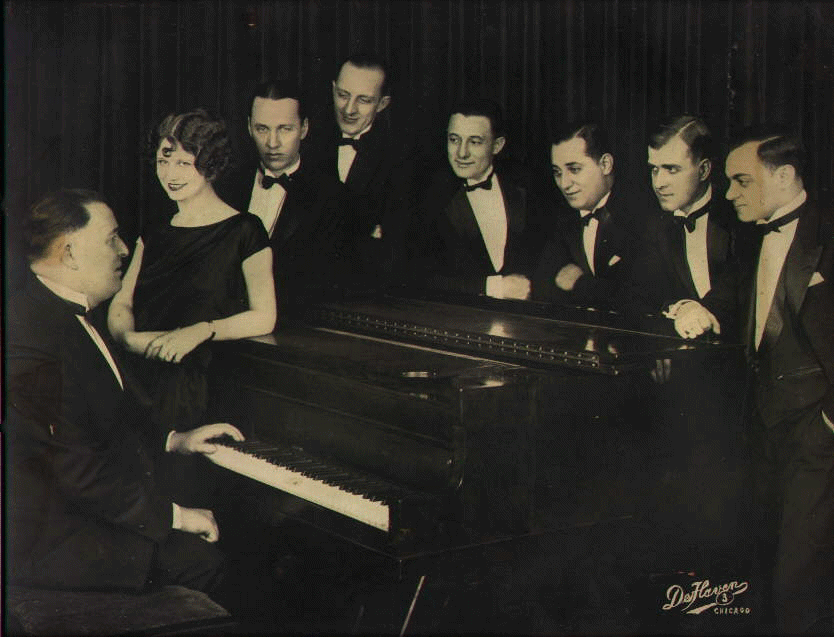 |
 |
It is important to note that Thelma’s sister Helen (who was ten or eleven at the time,and old enough at the time to be aware of her sister’s social life) doubts that Thelma ever dated Condon; but whatever the truth, Condon did capture much of Thelma’s strength of character in a few words. One might add, however, that top mob bosses like Capone often did have a gentlemanly side, and on occasion did offer protection to entertainers whose work they liked. Condon reports that in the spring of 1927, Thelma was hired by MCA to lead a band, and took the name “Thelma Terry.” How Thelma caught the attention of MCA is not fully known, but in April, 1927, she evidently became enough of a main attraction while playing bass at the Piccadelly Theater in Chicago that a reporter for Variety took notice. Variety published a regular column on showbusiness in Chicago as well as in other cities, and the April 6, 1927 issue, p. 26, includes the following on the performance of the Al Short-Ted Leary Band at the Picadelly (a movie theater in the Hyde Park section of Chicago):
"It's a good-looking girl at the bass viol, and she stomps and plays simultaneously. This girl holds the center stage and is the center of attraction-- that's the detraction. Still, she adds greatly to the band from a novelty standpoint."
| The next week, the Al Short-Ted Leary Orchestra featured in Variety
a full page ad complete with photograph of the entire orchestra (including
a hard-to-make-out figure of Thelma behind the stringed bass).
Whatever the full facts of the matter, Thelma was made director of a band
of male jazz musicians and sent on nationwide tour. The band appears to
have been very successful, and Thelma was a star. (MCA billed her
as “The Beautiful Blonde Siren of Syncopation”, “The Jazz Princess”, and
“The Female Paul Whiteman.”) A nighclub called “The Golden Pumpkin”
in Chicago seems to have been the band’s home. The Golden Pumpkin
billed itself as “The World’s Largest Chinese Cafe.” It was located
at 3800 West Madison Street, in a hotel on the edge of what was then a
major musical theater district, just across the street from Garfield Park.
(The building still stands, and now functions as a social wellfare agency.)
The Playboys may have been the house band. In any case, Thelma’s band seems
to have been one of those in which the best musicians wanted to play.
Bud Freeman, for example, grew tired of playing in the commercial Spike
Hamilton band, and paid another musician to substitute for him so that
he could play in Thelma’s band at the Golden Pumpkin.
The Playboys seems to have been primarily a touring band, however, playing at, for example, Atlantic City, New York, and Kansas City. Savannah, Georgia was the last stop during the summer of 1929. In 1928, Thelma Terry and her Playboys recorded six songs--four in Chicago and two later in New York, with one group of musicians in |
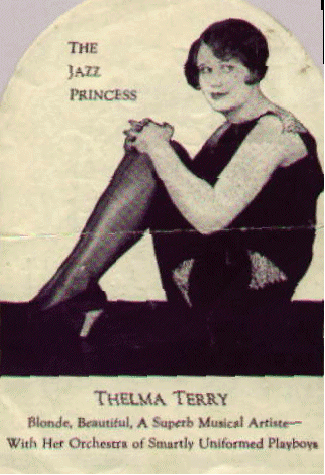
Copyright held by Thelma Terry's daughter, Patti, and used here by her permission. |
 |
Chicago and an entirely different group in New York. Bill Otto (who was pianist on the Chicago recordings, and who lived up until a few years ago) recalled Thelma as an extremely attractive (“even voluptuous”) woman, and that he got along with professionally because he did not try to “hit” on her, as the other members of the band did. Exactly what form this “hitting” took is unclear, but what is clear that the advances were unwelcome and unsuccessful.
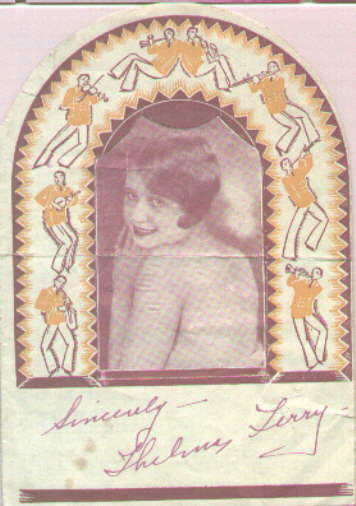
Terry's daughter, Patti, and used here by her permission. |
Another difficulty Thelma faced was insubordination from the male musicians.
Years before an effective Women’s Movement, and in an age in which
women were expected to work only until they got married, and then only
as schoolteachers, nurses, waitresses, or social workers, Thelma faced
the problem of how to lead male musicians who would not have have thought
it her place to do so--a problem experienced not only by her, but also
by other women musicians at the time.
Perhaps the greatest difficulty of all was the lonely nature of the work itself---days and days of boredom on trains and living in hotels. Thelma had led this life since she was a child, and had grown tired of it all--right at the time when her career seemed to offer the most promise. There is evidence that Thelma was a featured performer in the 1929 talkie “Broadway Scandals”; this could indicate that Columbia had plans for a possible movie career for her. What is certain is that they had planned for an international tour for the band starting in Berlin in 1929, and indication of the high position in the music business she enjoyed at that time. |
| Thelma’s escape was marriage. During the band’s stay in Savannah, Georgia
in the summer of 1929, she met Willie Haar, the enormously wealthy owner
of the winter resort at which the band was playing. Thelma not only quit--she
disbanded (fired) the band--and married Willie Haar in September of that
year, at the very time she was supposed to tour Europe.
MCA was very angry at Thelma for this action. At first, this probably did not matter, since Thelma had chosen another promising life for herself. But the marriage did not last. Her husband was also an independent person himself, but one who wanted a traditional wife. This was understandably not an easy role for Thelma. As daughter Patti puts it, “She was Thelma Terry”, a major luminary in the world of entertainment. She retained that persona. Patti was born in 1931, and several years after, the marriage ended (in 1936). After returning home to Michigan for a few years, Thelma went back to Chicago to make a comeback, but had a hard time finding work It is quite possible that MCA (who was a major booking agency for musicians at the time) had a hand in this, but the reasons are not yet completely clear. This was still during the Depression. Music and the music business were, of course, very different, and New York was now the center, not Chicago. Without a doubt, too, at least part of the reason for her difficulties had to do with the fact that she was a woman. However, musicians that she had helped like Gene Krupa and Bud Freeman were now international celebrities. Why did they not help her? |

Thelma (on reader's extreme right), with her mother and father (seated, holding Patti) in 1933. Copyright held by Thelma Terry's daughter, Patti, and used here by her permission. |
She ended up trying to make ends meet working as a kniting instructor. She turned her back on showbusiness and music--she sold her string bass. It was a very sad end to a great career and a great talent.
In the early fifties, Thelma moved to Miami, Florida, and lived there for most of the decade, returning to Michigan to visit family, and in 1956, on the occasion of Patti’s wedding. Music and showbusiness were thoroughly behind her. On occasion, however, she would visit old musical friends. In 1957, Thelma and daughter Patti went to see Gene Krupa in concert. They went backstage, and Krupa greeted Thelma warmly. Hollywood was making a movie about his life, and he was apologetic that it could not include the part that Thelma had played in his career (she had given him his first break), since her name was no longer known to the general public. Thelma graciously said that this was all right.
She moved back permanently to Michigan in the late fifties, to make granddaughter Cindy (born 1958) the center of her life. She was beloved in her home community, was well-known for her generosity, warmth and kindness.
Interestingly, she always disliked her first name "Thelma" (only showbusiness people called her that); friends and family called her "Terry"--hence her choice of "Thelma Terry" as a professional name. Since 1936, this was also her legal name.
Sadly, Thelma Terry died on May 30, 1966 of throat cancer. She was never to know that around the world, particularly in Britain, there were record collectors that valued the six records she made, and who wondered and cared about what had happened to her.
An article in the British popular music magazine, Melody Maker, dated February 28, 1948, provided by Tad Hershorn of the Center for Jazz Studies at Rutgers University, is accompanied by a striking 1920's photo of Thelma seated at a piano and facing the camera. The article itself belongs to an era different from ours, an era in which, sadly, women of talent and intelligence are referred to as "odd." The article begins with the response of a British record collector who thinks that piano great Bob Zurke is on one of Thelma's records (he is in fact on two of the recordings). The topic changes to trumpet great Rex Stewart, and then back to Thelma:
"The Jazz Princess. This is the not first time that Miss Terry has been mentioned in these columns. A while back we ran some stuff on Charles Fulcher and Thelma Terry, and several collectors maintained that Thelma plucked a punchy bass fiddle. Others doubted whether she had what it takes. Now we have Condon's word for it, and some additional dope on this odd young lady [sic.] who was billed as 'The Beautiful Blonde Siren of Syncopation...Describing her as 'The Jazz Princess' and 'The Female Paul Whiteman with her Merry Musicians,' the old MCA handout goes on to say that Thelma has several claims to distinction, such as having gained a reputation as first bass player at the age of eighteen with the Chicago Women's Symphony Orchestra. It mentions the Vanity Fair job and speaks of her as playing "Two years at the Lighthouse and shorter periods at the Piccadilly Theatre and Lincoln Tavern. Her career also included a feature role in the revue "Broadway Scandals." The only reference to the band claims that they were "youthful and good-looking playboys, smartly attired in colourful military uniforms.""Terry's Playboys. In our methodical way we turned up the files on Thelma and dug out photographs and publicity blurbs of the period. One fetching snap is printed here; another, and larger, photo showing the whole band is with us in the office, and we'll be happy to lend it to anyone able to identify any of the ten male musicians shown."
Various record companies rereleased her known six recordings over the years. From the liner notes of The Chicago Hot Bands 1924 ? 1928, Timeless Records (1997), Brian Rust, great British discographer, writes of Thelma Terry and the Playboys that: "This band... is surely one of the most remarkable in the history of jazz and dance music, for it was directed by a winsomely attractive young lady. Nothing in that, you may say; there were other bands that were led by similary attractive girls... but Thelma Terry was no slinky figurehead; she played string bass of all things, and did so with the taste and assurance associated with male exponents of the instrument, such as Pops Foster, Joe Tarto, Steve Brown, John Kirby, Wellman Braud, Bill Johnson ... A glance at the personnels of the two sessions recorded shows that here were some of the great names of Chicago Jazz, playing largely non-vocal versions of popular tunes of the time, propelled with ease by the dynamic little lady

Copyright held by Thelma Terry's daughter, Patti, and used here by her permission. |
with the big fiddle. What happened to her we wonder? She seems to have
vanished from the scene as quickly as she came into it."
There are some inaccuracies here. Thelma’s appearance on the music scene in Chicago was not sudden. She was not a “little lady”--according to her daughter Patti, Thelma was five feet seven inches tall. (In addition, as the photographs show, she was a brunette, not a blonde,as Condon had said--she occasionally dyed her hair blonde.) And we need not wonder what happened to Thelma anymore. But even though the original records Thelma made are extremely rare, but they still exist and are highly prized. And it is here that Brian Rust is right: the recordings testify to the talent and skill of a fine jazz musician, playing string bass with “taste and assurance.” Under her guidance, the band plays in tight rhythm in various styles of the time, but with a sound that does not seem dated, unlike the sound of many other bands of the period. Why should we remember Thelma Terry? She was talented and beautiful, and her story is of historical importance and interest. But in this she is not unique. Above all else, she was an extraordinary human being who tried to do something no woman had ever done before. She is a heroine for our times. |